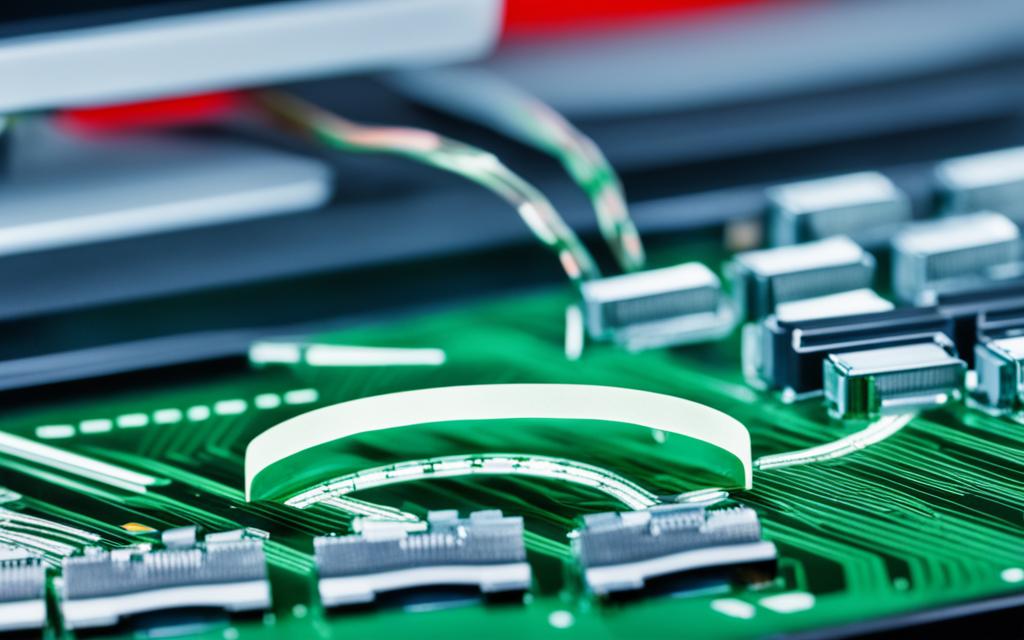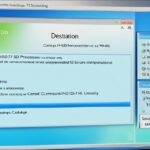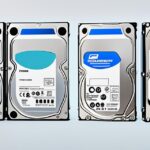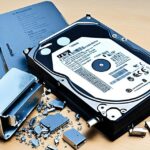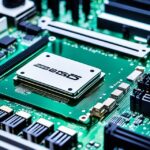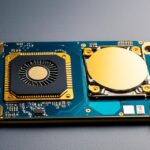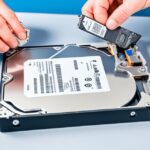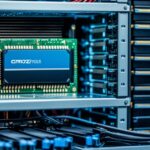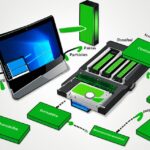Table of Contents
Cloning a hard drive is key for anyone wanting a better computing life. Especially for those using Windows 7. This guide will show you how to clone your Windows 7 HDD. You might want to upgrade storage, boost performance, or keep your data safe. By learning about cloning, you can easily move to new hardware. Recently, EaseUS Disk Copy has been praised for fast cloning. Plus, AOMEI Partition Assistant Professional is a favourite for Windows 712 users.
Key Takeaways
- Cloning a hard drive is a reliable way to upgrade your storage without reinstalling your operating system.
- Utilising cloning software simplifies the process of transferring data, applications, and settings.
- Preparing both source and destination drives is crucial for a successful cloning experience.
- Software like EaseUS and AOMEI offers guided instructions to help users through the cloning process.
- Regular backups are essential to prevent data loss before commencing any cloning activity.
Why Is Cloning a Hard Drive Necessary?
Cloning a hard drive offers many great benefits. It helps users boost their computer’s performance and manage data better. With a clone, you can move all your files and settings to a bigger hard drive easily. You won’t have to reinstall your operating system again. Cloning makes an identical copy of your hard drive. This helps when you’re switching to a new drive.
Upgrading Your Storage Capacity
The need for more storage becomes obvious as our digital needs grow. Cloning helps you move to a bigger drive without losing any data. DiskGenius is a popular tool that makes cloning easy3. Make sure the new hard drive is big enough to hold all your data.
Enhancing Performance with SSDs
Switching to SSDs can greatly improve your computer’s performance. Cloning to an SSD speeds up start-up times and data transfers. This makes them much faster than old HDDs. Brands like Samsung provide easy-to-use cloning tools4. SSDs can really change how fast your system runs, especially if it was slow before.
Creating a Backup for Data Recovery
Cloning is key for making solid backup systems. It helps with recovering data if there’s hardware failure or data gets corrupted. By cloning regularly, you can get your system back to how it was quickly5. Cloning tools ensure your backups are complete and accurate. This lets you recover smoothly when needed.
Preparations Before Cloning a Hard Drive
Before you start cloning your hard drive, you must prepare well. Firstly, choose the right HDD or SSD for your data. Make sure it fits all your original data to avoid any loss.
Choosing the Right Hardware
Choosing the right hard drive is key for a smooth cloning. Make sure the new drive connects well to your computer. Check these connections carefully. AOMEI Backupper Professional is a top choice for moving data to a new drive easily6.
Ensuring Sufficient Disk Space
Having enough disk space is crucial. Confirm the new drive can hold all data from the old one. If needed, clean up to free space. This step ensures a smooth data move and boosts SSD performance7.
Backing Up Important Data
It’s vital to back up data before cloning. This protects your important information if problems arise. Use reliable backup software like EaseUS Todo Backup for added security5.
Benefits of Using Cloning Software
Cloning software offers many benefits, making hard drive copying easy while keeping your data safe and sound. With a tool like EaseUS Disk Copy, moving to a new PC is a breeze. You can keep all your apps, files, and settings without hassle8. This is especially helpful when switching from an old HDD to a faster SSD. Such a change can really speed things up, exciting many users8.
Ease of Use and Efficiency
Advanced tools have a user-friendly setup. This makes the cloning process easy, even if you’re not a tech whiz8. Macrium Reflect, for example, guides you through every step. It makes cloning simple for everyone. It’s ideal for both personal use and setting up many computers at work9.
Time-Saving Features
Time-saving options in cloning software are key for reducing downtime. They’re great for upgrades or moving to a new machine. Being able to quickly go back to an earlier system setup is fantastic for fixing problems or recovering after hardware issues9. Quick cloning means you can move to a new system without delays, boosting your work efficiency and system dependability.
Advanced Recovery Options
Premium cloning software stands out with its advanced recovery features. These tools let you back up everything and fix issues or hardware problems with precision9. Using software with strong recovery features ensures you can save important files or your whole system. It also means you’re following good data storage rules, like the 3-2-1 backup strategy9.
How to Clone Windows 7 HDD
Cloning a Windows 7 hard drive needs a careful, step-by-step process. This ensures success and keeps data safe. Picking the right cloning tool, like AOMEI Backupper or DoYourClone, is key. These tools are great for Windows 7, 8, 10, and 111011. They offer easy-to-use interfaces and strong features.
Step-by-Step Guide to Cloning
First, install your chosen cloning software and get your system ready. You need to know which drive has your info and where you want to put it. AOMEI Backupper lets you clone to any size drive and still start your PC without trouble10.
You can choose how to clone and set up partitions. This makes the cloning more efficient and personal.
Using the Right
AOMEI Backupper is great for its cloning features10. It works with different partition styles – MBR and GPT. The “hot clone” feature means you can use your computer while cloning. DoYourClone is also good, making bootable disk clones easy and keeping your data safe11.
Preparing Your System for Cloning
Getting your system ready for cloning is crucial. Back up your data before you start. Make sure the drive you’re moving your data to is connected properly. You might need to check BIOS settings to work with the new hardware during cloning1011.
Post-Cloning Steps and Troubleshooting
After cloning, it’s key to take some steps to make sure things work well. First, check that all files and apps have moved correctly to the new disk. It’s crucial for trusting the update and keeping your data safe.
Verifying the Cloning Process
Checking the cloning is a must-do. It ensures everything, including data and apps, is where it should be. Spot any issues early to prevent future problems.
Boot Order Adjustment in BIOS
Then, tweak the BIOS boot order to make the new disk start first. If you skip this, your computer might start from the old disk. By adjusting BIOS settings, your machine will boot smoothly.
Ensuring Compatibility with New Hardware
For SSDs, BIOS settings might need changes, like UEFI and Legacy boot modes. This is key for top-notch performance and reliability.
Also, see if the new drive shows up in Disk Management. A reboot may be needed to apply changes fully. Cloning hard drives is common in IT and cybersecurity. It makes sure businesses run without glitches. The efficiency of these steps is essential for that smooth flow1. Following these steps helps sort out any clone-related problems12.
Conclusion
Cloning a Windows 7 HDD brings many benefits. It enhances your computing experience. Users can upgrade storage, improve performance, and make safe backups.
Using tools like AOMEI Backupper and AOMEI Partition Assistant Standard makes it easy. These tools have features that fit your needs. They let you clone your hard drive without stopping your work, reducing downtime10. This guarantees you have enough space and compatibility13.
Cloning your drive improves your work flow and shows you care about your data. As SSDs become cheaper and more reliable, upgrading is essential. It keeps your digital world running smoothly14. Learn more about copying techniques and Windows Clipboard at this guide.
FAQ
Why should I clone my Windows 7 HDD?
Cloning your Windows 7 HDD is key for more storage, better speed with SSDs, and having a backup for recovery. This process lets you move data to a new drive smoothly, without missing anything.
What software do I need to clone my hard backup?
For cloning, use trusted software like EaseUS Disk Copy or AOMEI Backupper. They are easy to use and automate the process to avoid any hassle.
How do I prepare for cloning my hard drive?
First, pick the suitable hardware and make sure the new drive has enough space. Then, back up your valuable data. These steps prevent data loss and ensure a smooth cloning process.
What should I do after cloning my hard drive?
After cloning, check if all files and apps are correctly moved. Then, set the new drive as the main device in BIOS settings. Also, make sure it works well with your system. This ensures your system operates efficiently.
Is there a risk of losing data during the cloning process?
While cloning is mostly safe, there’s a small risk of losing data. Always backup crucial files first. This way, you can recover your data if needed.
Can I clone a hard drive with different storage sizes?
Yes, you can clone drives of different sizes, like from a smaller HDD to a bigger SSD. Just ensure the new drive can hold all the data from the old one to prevent data loss.
What if my new SSD isn’t recognised after cloning?
If the new SSD isn’t recognised, ensure it’s properly connected and seen in Disk Management. Also, check your BIOS settings to make sure the SSD is set up right for your system.
How long does the cloning process take?
The cloning time depends on the data amount and drive speeds. Usually, cloning to an SSD is quicker than to another HDD because SSDs are faster.
Source Links
- https://www.easeus.com/disk-copy/clone-resource/how-to-clone-a-hard-drive-in-windows-7.html – How to Clone A Hard Drive in Windows 7(No OS Reinstalling)
- https://www.diskpart.com/windows-7/clone-windows7-to-new-hard-drive-7201.html – How to Clone Windows 7 to New Hard Drive Without Reinstallation?
- https://www.pcmag.com/how-to/how-to-clone-a-hard-drive-on-windows-pc-mac – How to Clone a Hard Drive on a PC or Mac
- https://www.easeus.com/backup-utility/what-is-disk-cloning-and-why-is-it-necessary.html – What Is Disk Cloning and Why Is It Necessary
- https://www.avg.com/en/signal/how-to-clone-a-hard-drive – How to Clone a Hard Drive
- https://www.ubackup.com/clone/clone-hard-drive-windows-7-0528.html – How to Clone Hard Drive in Windows 7 without Reinstalling: 4 Steps
- https://www.diskpart.com/clone/copy-hdd-to-hdd-0310.html – How to: Clone HDD to HDD in Windows 11, 10, 8, 7
- https://www.macrium.com/blog/how-to-migrate-your-old-pc-to-a-new-one-67af145e5a23 – Cloning a Disk with Macrium Reflect 7 | Macrium Software
- https://www.acronis.com/en-gb/blog/posts/cloning-software/ – The Best Disk Cloning Software of 2024 – Acronis
- https://www.ubackup.com/windows-7/clone-windows-7-to-new-hard-drive.html – How to Clone Windows 7 to New Hard Drive or SSD (2 Ways)
- https://www.doyourdata.com/disk-copy/create-bootable-disk-clone-for-windows-7.html – How to Clone Windows 7 and Make It Be Bootable?
- https://grdnr.io/post/2012-07-28-cloning-a-hard-drive-in-windows-7/ – Cloning a hard drive in Windows 7 | Joe Gardiner
- https://www.diskpart.com/disk-transfer/clone-hard-drive-windows7-64-bit.html – How to Clone Hard Drive Windows 7 64 Bit Easily and Quickly?
- https://www.easeus.com/disk-copy/clone-resource/clone-hdd-to-ssd-windows-7.html – How to Clone HDD to SSD Windows 7 Without Data Loss

